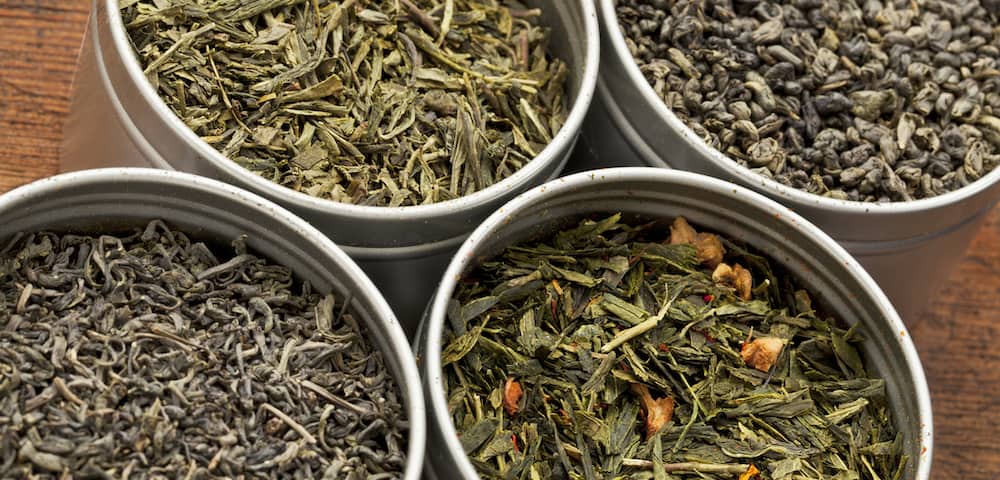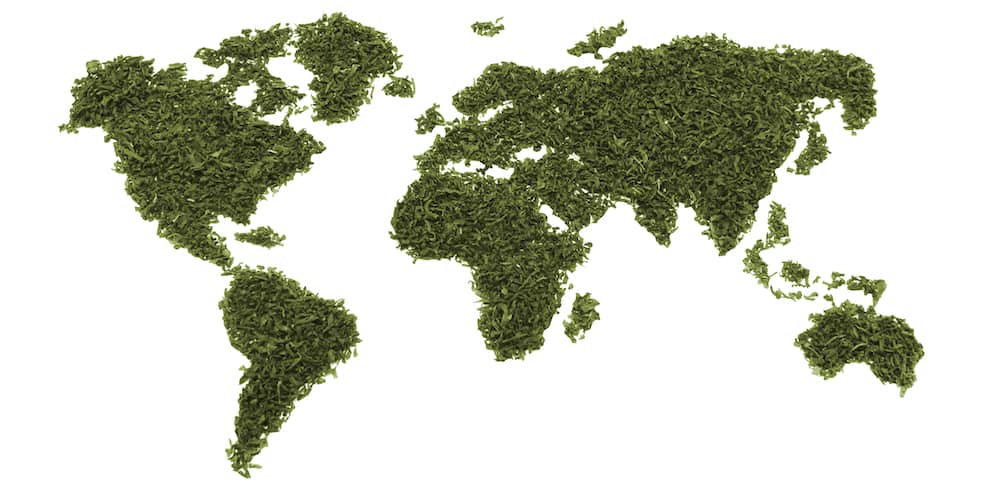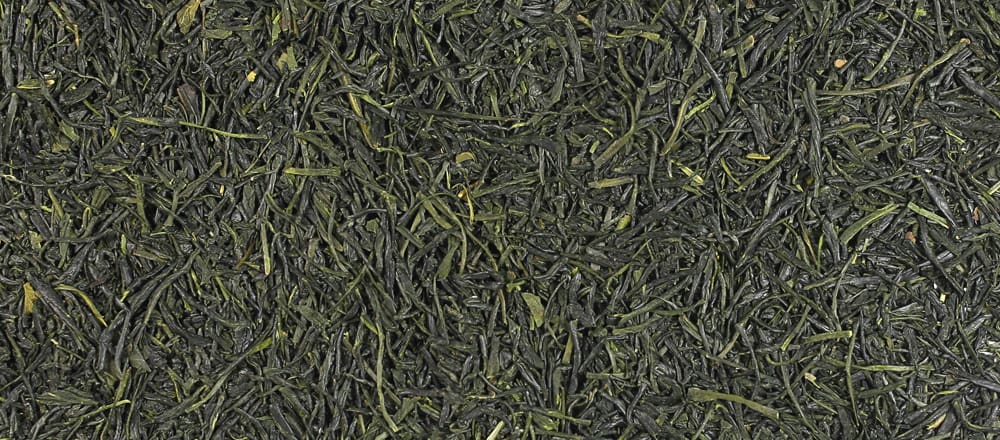Different Green Tea Types

Did you know there are hundreds, if not thousands, of Green Tea types? From Sencha to Gunpowder; Jasmine to Decaf, Matcha and Organic, the possibilities are nearly endless.
While the article below won’t, of course, cover all of them, it’ll aim to showcase the most famous types of Green Tea. Whichever one you choose from the list below, you’ve undoubtedly decided exceptionally well.
Keep reading to find out more about this incredible world and all it has to offer. And once you know the facts, be sure to buy from us. The Kent and Sussex Tea and Coffee Company pack every Loose Leaf Tea, Tisane and Coffee fresh to order. This is our way of guaranteeing not only quality but also consistency. What more could you want from your new favourite brew?
Table of contents
- Green Tea Types by Country
- Chinese Green Tea
- Japanese Green Tea
- Indian Green Tea
- Green Tea Types by Profile
- Sencha Tea is a Very Popular Type
- Matcha Tea, a Type with Tradition
- Gunpowder Tea is Another Type of Green Tea
- Gunpowder Tea is Another Type of Green Tea
- Many Flavoured Green Tea Types
- Jasmine Green Tea
- Decaffeinated Green Tea
- Organic Green Teas
- What Type of green tea Should You Buy?

Green Tea Types by Country
Already, 20% of Tea drinkers choose one of countless types of Green Tea (78% choose Black and 2% another variety, in case you’re wondering). Most of these come from three countries: China, India and Japan.
While there are other nations that make Green Tea types, including Vietnam, Thailand, Sri Lanka and Nepal, most kinds come from the ‘big three’.
As such, let’s start by exploring the primary countries where this extraordinary beverage grows. Whether it’s the vast Wuyi mountains of Fujian, the rolling hills of Darjeeling or the idyllic plantations of Shizuoka, each location has something unique to offer.
Perhaps more importantly, they all make exceptional-tasting Green Tea.

Chinese Green Tea
China is the home of Green Tea. According to legend, it dates back to 2737 BCE when an ancient Emperor named Shennong (神農 or Sheng Nung) discovered tea it by pure accident!
The story goes that after spending his day experimenting with herbs, Shennong decided to rest under an unknown tree. He eventually fell asleep in the midday sun with a cup of boiling water by his side.
While the Emperor dozed, a gust of wind came through the tree. Leaves fell to the ground, with some landing in Shennong’s drink. The leaves began to infuse with the water.
When Shennong awoke, he discovered a strange, greenish beverage next to him. Intrigued, he decided to try it. The Emperor was delighted by the scent and delicious taste. It was, of course, Green Tea.
Many hundreds of years later, during the eighth century CE, a writer named Lu Yu published a book on this fascinating infusion. This ultimately gave rise to its popularisation.
For a time, only royalty could drink it, at which stage it became a so-called “Tribute Tea”. Later during the Song dynasty (960-1279), however, it was made available to the masses.
Today, drinking Green Tea is an integral part of Chinese culture and society, accounting for approximately 50% of its consumption worldwide. It’s no real surprise, then, that it’s also the nation where some of the most famous and popular Green Tea Types come from.
This includes Sencha, Matcha, Gunpowder and Jasmine – among many, many others.

Japanese Green Tea
Japan is the second-largest consumer of Green Tea, with some 80,000 tonnes of it drunk every year. An estimated 78% of this is Sencha. However, the land of the rising sun also boasts several types of Green Tea unique only to them.
It’s a history that dates back to at least 1191 CE. This was when a Buddhist monk named Eisai introduced the Japanese to the wonders of Tea-drinking for health benefits.
In his book entitled “Kissa Yojoki – How to Stay Healthy by Drinking Tea”, Eisai wrote: “Tea is the ultimate mental and medical remedy and has the ability to make one’s life more full and complete.”
Years later, in 1214, the monk brought Green Tea to the Samurai. Eventually, and much like its Chinese neighbour, drinking it became a way of life in Japan.
Little has changed today, with Green Tea continuing to make up a sizable part of Japanese culture. Wherever you go in the country, be it a restaurant, kiosk or even a vending area, you’re bound to find a plethora of Green Tea types. Children often receive it free with meals, while tourists and locals alike have it presented to them at public gardens and temples.
There is even a Japanese Tea ceremony – but we’ll talk more about this later. Right now, it’s worth noting the types of Green Tea one can find in Japan.
This includes Bancha, an infusion similar to Sencha, and Gyokuo, which is a shade-grown variety high in antioxidants. Perhaps most unusual of all is Kukicha, a Japanese Tea made from stems and stalk of the Camellia sinensis plant.

Indian Green Tea
Green Tea may have arrived in India at the same time as Japan. Nowadays, however, the country most famously produces Black Tea – especially Chai Tea.
When it comes to the history of Indian Tea, regardless of the type, production didn’t start until the 19th century. This is because, until the mid-1800s, British attempts to cultivate the Chinese Camellia sinensis (Tea) plant had failed.
It was a Scottish explorer named Robert Bruce who discovered an Indian variety of the Tea plant growing in Assam in 1823. This went on to become known as Camellia sinensis var assamica.
Not long after these incredible findings, a flourishing Indian Tea industry emerged. The country hasn’t looked back since. Now, India is the second-largest Tea producer in the world, though only a small percentage is Green Tea.
Then how, exactly, has Indian Green Tea become so popular if the country produces so little? It’s all about the quality. Indeed, both the State of Assam and the West Bengal district of Darjeeling make several exceptional types of Green Tea.
If this has piqued your interest, why not try Organic Makaibari Darjeeling Green Tea SFGFOP1?

Green Tea Types by Profile
It’s time for the nitty-gritty of Green Tea types. We’ve learnt about the countries of India, Japan and China, as well as many others, and how they all make individual varieties. But now, let’s dive deep into the details and find out what each one has to offer.
Below, you will find information on Sencha, Matcha, Gunpowder, Moroccan Mint, Flavoured, Jasmine, Decaf and Organic Green Tea.
Additionally, we will also look into the difference between Green Tea Bags and Loose Tea, explaining why certain people have a preference.
As mentioned already, there are hundreds of other types of Green Tea. Those found here are but the most famous.

Sencha Tea is a Very Popular Type
When you brew up a cup of ‘regular’ Green Tea, the chances are you’re drinking Sencha. It is a beverage most commonly associated with Japan.
However, evidence suggests that it originated from China. And yet a fascinating legend persists, one alluding to the notion that a Japanese farmer from Uji, near Kyoto, created this infusion in 1738.
According to the tale, a man named Nagatani Sōen had experimented with different production techniques before perfecting the art of making Sencha. Nagatani travelled to Edo (present-day Tokyo) to sell his creation. There, he visited a local Tea shop.
The owner of the shop fell in love with the infusion, dubbing it “tenka ichi” (天下一), meaning “first under the heavens”. Such was the demand for Sencha that the Tea shop’s business increased.
Out of gratitude, the owner carried on sending money to Nagatani for the rest of his life, and then to his family after he passed away. A sweet story, undoubtedly, but China is nevertheless the likely home of Sencha.

Matcha Tea, a Type with Tradition
Matcha is one of the most extraordinary Green Tea types or White Tea, sometimes! available. What makes it different from your ‘regular’ cuppa is the fact that it has been ground into a fine powder.
This remarkable processing method has a significant influence on the taste and texture of Matcha, as well as its well-documented Matcha Tea benefits.
According to research, it contains 137 times more antioxidant strength than normal loose leaf Green Tea. This enables it to combat free radicals in the body, the product of natural, though harmful, human oxidation.
In doing this, Matcha can reduce the risk of developing several chronic conditions, including type-2 diabetes and cardiovascular disease. Perhaps most famous, though, is its grassy, astringent taste.
Although it doesn’t suit every palate, people seem to agree that Matcha Tea is, at the very least, unique. And it’s this uniqueness which has endeared so many for several hundreds of years, particularly in Japan.
Indeed, since the 17th century, the Japanese have held Matcha Tea ceremonies. This quiet celebration, performed with grace and beauty, is a spiritual experience, cleansing the body and the mind.

Gunpowder Tea is Another Type of Green Tea
Gunpowder Green Tea is a Tea made from leaves shaped into small, round pellets. These pellets unfurl before one’s eyes when brewed, creating a beverage noted for its grassiness and earthiness.
It originates from the Zhejiang province, south of Shanghai, China. However, other provinces create it, too, including Guangdong, Anhui, Hunan and Fujian. And there is also Formosa Gunpowder, a Taiwanese type.
But why “Gunpowder” Tea? There are a few theories, although no one knows with any certainty. The first theory is that an English clerk gave it this name after seeing the strange shape of the leaves.
According to this tale, he thought Gunpowder Tea resembled the appearance of lead shots used in muskets.
Another theory suggests that the word “gunpowder”, when spoken in the correct dialect, sounds like the Mandarin Chinese phrase for “freshly brewed”. Finally, some believe that the name derives from the ‘crackling’ sound it makes while infusing with hot water.

Gunpowder Tea is Another Type of Green Tea
Rather than a “type” of Tea per se, Moroccan Mint Tea is the combination of Gunpowder Green Tea and peppermint leaves. A “sub-variety”, if you will.
The name comes from its immense popularity in Morocco. In fact, it’s the National Drink! Historically, Moroccans have drunk this beverage since at least the 18th century. Other terms for it include “Maghrebi Mint Tea”, “Sahrawi Mint Tea” and “Touareg”.
Traditionally, if you’re invited into a home for a cup (or three!) of Moroccan Mint Tea, it signifies hospitality and affection. This often involves an almost ritualistic Tea-preparing ‘ceremony’ adhering to the saying “Insha Allah”, meaning “with God willing, all good things will come with time.”
Brewing it is an art-form passed down through generations. The male “head” of the family usually conducts the ceremony. However, being 2020, there are, thankfully, exceptions to this rule.
After several stages (which you can read more about in our “Gunpowder Tea” article), the finished product is, put simply, exquisite. Expect traditionally grassy flavours with distinct minty undertones.

Many Flavoured Green Tea Types
Moroccan Mint isn’t, of course, the only flavoured Green Tea type. There are dozens – many of which we stock here at The Kent and Sussex Tea and Coffee Company.
While Peppermint Green Tea remains a favourite, others include Flavoured Gingerbread Green Tea, Green Tea and Elderflower, and Mango Green Tea. Furthermore, we have Banana Green Tea, Cinnamon and Plum Green Tea and more.
There is a common misconception that flavoured infusions such as these lack quality. Although this might be the case for some companies, it’s certainly not the way we do things here.
Indeed, all of our flavoured products boast the same outstanding character and charm as any of our unflavoured counterparts. It’s merely a different character, a different kind of charm.
We aim to use the finest quality Green Tea leaves regardless of the ingredients we add to it. Furthermore, where possible, we try to include only all-natural flavouring, often in addition to the ACTUAL fruits and/or herbs themselves.
Cucumber and Melon Green Tea, for instance, contains unmistakably real cucumber pieces. The same is true of Rose Green Tea, which boasts genuine petals.

Jasmine Green Tea
Perhaps the most famous out of the flavoured Green Tea types, though, is Jasmine Tea. Rarely does one’s morning cuppa get sweeter, grassier or more irresistibly floral than this heavenly infusion.
The flowers themselves derive from a genus of shrubs and vines known as Jasminum. It belongs to the olive (Oleaceae) family, with its use in commercial products unmistakably widespread.
Indeed, soaps, shampoos, lotions and perfumes are just some of the items that often contain Jasmine. Furthermore, and perhaps more importantly, there is Jasmine Green Tea. This is the product of an intricate, time-consuming, yet worthwhile processing method.
At night, while the flowers are blooming, workers layer them over Tea for scenting. After several hours, the leaves absorb the fragrance and distinct flavour of Jasmine, creating a beverage unlike any other.
In addition to Jasmine Green Tea, it’s worth noting that there’s also Jasmine White Tea. Furthermore, we stock a Jasmine Herbal Tea.

Decaffeinated Green Tea
Do you find yourself suffering from the negative Effects of Caffeine? You’re not the only one. People who’re caffeine-sensitive often suffer from jitteriness and sleeplessness after consuming too much of this stimulating chemical compound.
Meanwhile, medical professionals urge those who’re pregnant to limit their caffeine intake to 200 mg daily – the equivalent of two Coffees.
Is there an alternative? Yes – Decaffeinated Green Tea. The term “Decaf” refers to the process of decaffeination, whereby Tea leaves have the caffeine contained within removed.
Although trace amounts remain, the decaffeination process ultimately sees the product all but void of this naturally-occurring substance. Four primary methods of doing this exist. However, with Tea, we use only one.
This is the CO2 method, the safest and most efficient decaffeination process. It works by using pressurised liquid carbon dioxide to extract small caffeine molecules, removing 96-98% from the leaves. Best of all, removing Caffeine in Green Tea has little to no impact on the taste of the Tea!

Organic Green Teas
The term “Organic” refers to the way agricultural products are made without using pesticides, insecticides, bio-engineered genes or petroleum/sewage-based fertilisers.
Every Organic Tea, including several types of Green Tea, is certified by the regulatory body within the producing country. It is then checked and certified again as it enters the European Union (EU).
The EU regulations on organic products are robust and uniform across Europe. Each container of Tea is checked and sampled, and if it fails inspection, the container is resealed and returned to the country of origin.
As such, all Green Tea types deemed “Organic” comes with a guarantee of authenticity. But what is the purpose of Organic Tea in the first place?
Sometimes in this world, little changes make a big difference. Going with Organic Green Tea, for example, supports mother nature in a multitude of ways.
It maintains not only the environmental state of the land used for Tea-growing, but also the areas surrounding it. This ultimately helps to protect biodiversity, as well as ensuring the wellbeing of those who work in the industry.

What Type of green tea Should You Buy?
Now for the hardest part of all: choosing your new favourite Green Tea types. One factor worth considering before making this decision is whether to opt for Green Tea Bags or Loose Tea. Both have their pros and cons.
Both are available here at The Kent and Sussex Tea and Coffee Company.
In this day and age, Tea Bags undoubtedly rule supreme. It’s a convenience thing for the most.
Many of us, it seems, simply haven’t got the time to brew Loose Leaf Tea. As such, we stock several Tea Bag options to make life a little easier.
This includes a few Green Tea types, all of which can be enjoyed within mere minutes.
Yet Loose Leaf might soon return and once again challenge Tea Bags for the limelight. This is in part due to the fact that connoisseurs describe it as stronger, indeed better, in flavour when compared to Tea Bags.
The good news is that we also stock several Tea accessories to make opting for Loose Leaf slightly more straightforward.
Whatever you decide, be sure to buy from us. Start browsing our expansive selection of Green Tea, either choosing Loose Leaf or Tea Bags, and put the kettle on!

 Loose Leaf Tea
Loose Leaf Tea Pyramids
Pyramids Tea Bags
Tea Bags Africa
Africa Assam
Assam Ceylon
Ceylon Chinese
Chinese Darjeeling
Darjeeling European
European Indian
Indian Japan
Japan Nepal
Nepal South East Asia
South East Asia Ayurveda Tea
Ayurveda Tea Black Tea
Black Tea Chai Tea
Chai Tea Flowering Tea
Flowering Tea Fruit Tisanes
Fruit Tisanes Green Tea
Green Tea Herbal Tea
Herbal Tea Matcha Tea
Matcha Tea Oolong Tea
Oolong Tea Organic Tea
Organic Tea Pu erh Tea
Pu erh Tea Rooibos Tea
Rooibos Tea White Tea
White Tea Asian Coffee
Asian Coffee Caribbean Coffee
Caribbean Coffee Central American Coffee
Central American Coffee South American Coffee
South American Coffee Coffee Blends
Coffee Blends Decaffeinated Coffee
Decaffeinated Coffee Espresso Coffee
Espresso Coffee Ethically Sourced Coffee
Ethically Sourced Coffee Flavoured Coffee
Flavoured Coffee Organic Coffee
Organic Coffee Single Origin Coffee
Single Origin Coffee Chocolate 1
Chocolate 1 Chocolate 2
Chocolate 2 Chocolate 3
Chocolate 3 Chocolate 4
Chocolate 4 Chocolate 5
Chocolate 5 Chocolate 6
Chocolate 6 Chocolate 7
Chocolate 7 Chocolate 8
Chocolate 8 Chocolate 9
Chocolate 9 Loose Tea Filters
Loose Tea Filters Tea Accessories
Tea Accessories Tea Bricks
Tea Bricks Tea Caddies
Tea Caddies Tea Caddy Spoons
Tea Caddy Spoons Tea Gift Ideas
Tea Gift Ideas Tea Infusers
Tea Infusers Tea Strainers
Tea Strainers